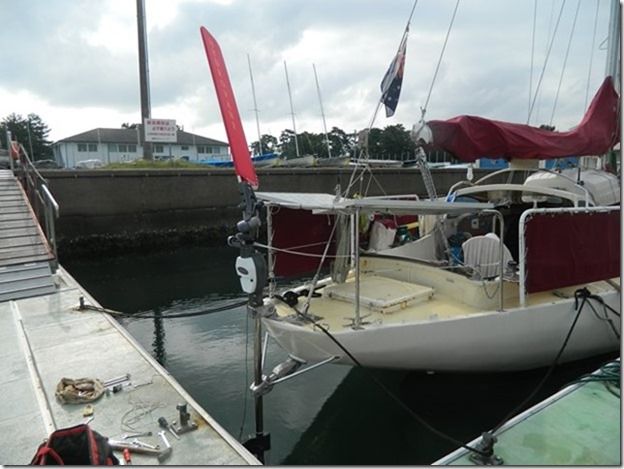True Stories
Page 24 of 42
 Contessa 32
Contessa 32
“Let me commend you and the Hydrovane team on a very comprehensive and thorough website (as well as effective self-steering product).”
From: Mike Parkes
Sent: August 08, 2014
To: Will Curry
Subject: Hydrovane Reference Material – Offline e-Version Request
Will,
Let me commend you and the Hydrovane team on a very comprehensive and thorough website (as well as effective self-steering product). I have owned and operated my Hydrovane for several years now, and when I have questions about operation and maintenance, I am always able find my answers online at your website or in the paperwork that shipped with my unit.
Yours aye,
Mike Parkes

 Roberts Spray (Steel)
Roberts Spray (Steel)
LOA 45, 17 tonnes/37,000 pounds
“I have sailed half way around the world solo with only my Hydrovane to self steer. It is a fantastic piece of equipment and probably the last item I would get rid of on the boat because it is so reliable.”
From: Nick Dwyer
Sent: August 6, 2014
To: Hydrovane
Subject: Testimonial
Hallo Hydrovane people!
I moved on to my boat in 2008 am still living on board. I have sailed half way around the world solo with only my Hydrovane to self steer. It is a fantastic piece of equipment and probably the last item I would get rid of on the boat because it is so reliable. The only time it let me down, was in 2009, I was one month out with one month to sail before land fall, using my SSB a ham radio user contacted you explaining my predicament and within 24 hours I was provided with the dimensions of the part that I needed to replace (the ratio arm) I was able to Jury rig using what I had on board and made it to the destination with no further troubles. So I would say that not only is the product brilliant but so is the after sales service.
Thanks
Nick
Contact
 Beneteau 423
Beneteau 423
“We discovered why our insurance company loves Hydrovane and we soon came to love “him” ourselves.”
From: Mike and Carol Kefford
Sent: August 02, 2014
To: ‘Will Curry’
Subject: RE: Hydrovane
Beneteau Oceanis 423 / Mike and Carol Kefford
Our Hydrovane was fitted by us (with the help of an engineer friend) in Gibraltar in 2011, having had it shipped there as we prepared to cross the Atlantic after three years cruising in the Mediterranean. Fitted with an excellent “stubby” wind vane to fit under the solar panel arch, we were able to learn how it worked and how we could best use it during our passage to Cape Verde via the islands of Madeira and Lanzarote. In particular, we understood how important it was to balance the sails so that the Hydrovane was not fighting to correct weather helm or lee helm. We discovered why our insurance company loves Hydrovane and we soon came to love “him” ourselves.
Like all other cruisers our steering assistants take on a personality of their own. Our Raymarine autopilot aka “Wilhelm” now had a companion “Barret”. So named after “Barret” Bonden, the coxswain in the Patrick O’Brien books, a favourite series of eighteenth century British Naval books and from which the film Master and Commander was made.
Barret was to steer us across the Atlantic in December 2011, to the Bahamas and North America in 2012 and back through the Caribbean in 2013 to Trinidad. We went through the Panama Canal in March 2014 and arrived in the Galapagos Islands in April.
The trip from Galapagos to the Marquesas Islands was to be our longest passage with just the two of us on board and “Barret” was an essential crew member for the 3000 mile crossing. He requires no power, we do not have to feed him and he never sleeps. He is the perfect crew member.
We departed from Academy Bay, Santa Cruz, Galapagos on 15 April and ran SW for the first few days with light winds between 4 and 12 knots, with the cruising chute pulling us along and Barret doing all the work. On 17 April a False Killer whale swam alongside the yacht, so close that Carol’s toes are in the photograph.
From 19 April to 3 May we travelled more westerly as the SE Trade Winds kicked in with 15 to 25 knots. However, from 25 to 30 April we also had a period of severe squalls and torrential rain. The wind was often gusting 30 to 40 knots on the edge of the squalls with the seas uncomfortably confused with crossing waves on top of the 3 metre southerly swell. During this period we often needed to hand steer for hours at a time as neither “Wilhelm” nor “Barret” could cope with the breaking following seas. This was not a reflection on “Barret” but on our steering wheel locking system which kept being thrown hard over by the following seas. We were reluctant to tie it down hard for fear of the forces breaking the rudder. We have since learnt to trust the strength of the yacht, to tie the wheel and let “Barret” do the rest.
From 4 May the squalls became less frequent, the seas were calmer and the wind backed to the east. At 10 degrees 20 minutes south we tacked back to the north for 24 hours to give ourselves a better angle of approach to the most southerly of the Marquesas’, the island of Fatu Hiva. We were then able to sail almost dead downwind with headsails poled out on either side and “Barret” doing a fine job on this most difficult point of steering.
We sighted the dramatic profile of Fatu Hiva at 0530 on 9 May, shortly after which the wind died for a while and we had to put “Barret” in neutral and motor sail until we rounded the northern tip of the island. The final three miles to Bay on Fatu Hiva was hand steering as it was such an emotional moment to approach that spectacularly beautiful bay.
Our passage had taken us 24 days, not fast at all as our conservative sail plan had been intended to look after the yacht, especially during the prolonged period of bad weather, and we still had 4000 miles to go to Australia. “Barret” had steered us the majority of the way and he and Tashi Delek had looked after us very well. We cannot wait for the next leg of the voyage and to see “Barret” deliver us, via the Tuamotus, Cook Islands, Niue, Tonga, Fiji, Vanuatu and New Caledonia to Bundaberg, in Queensland, Australia.
Contact
 Newport 41
Newport 41
“‘Gertrude’, from what we tried so far, is working well.”
From: John Kloppenburg
Sent: Monday, August 04, 2014 6:24 PM
To: Will Curry
Subject: Re: Ali Oop in False Creek
Gertrude, from what we tried so far, is working well. I’m sure that she will steer the boat for us and I will keep you up to date with our travel and let you know how she performs. I have attached a few pictures of the install. I hope all is well with you and your family. John
Contact
 Jeanneau SO 40
Jeanneau SO 40
“…put in one reef in the main and all went perfect straight away. No more than 5 / 6 dgrs veering either side. So all happy! I have to start thinking a little more in cruising terms instead in fast, faster, fastest.”
Will: “It always amazes me that when you reef early there is generally very little loss in boat speed and the boat is more comfortable. We had at least one reef in our mainsail the whole way across the Pacific and we still had multiple 180 mile days.”
From: Palma Maritime Marco
Sent: July 13, 2014
To: Will Curry
Hi Will,
I have successfully installed the Hydrovane and have used it several times now. It´s an amazing unit, which is very easy to use. I do have 2 questions though, which hopefully you can shed some light on.
- What is the function that you can tilt the vane back?? When would u use that? I can´t really find much info on it.
- Sailing into a straight-ish line seems difficult: I have been trying the 3 different “gear” settings and it doesn’t seem to make much difference which I use, but there is quite a sway from a straight line at time. I suppose my type of boat is relatively “nervous” when it comes to wind gusts and the hydrovane just doesn’t react as quick as an electric autopilot, but sometimes the sway of the straight line is like 15 degrees either end, which seems a lot to me.
Any thought in that?
Thanks and with best regards
Marco
—
From:Will Curry
To: Palma Maritime Marco
Sent: July 15, 2014
Hi Marco,
Good to hear you got your Hydrovane installed.
The vane axis inclination is used to reduce the sensitivity of the vane in heavy weather. For most conditions you shouldn’t have to use this. You only want to incline the vane when it appears to be over steering.
You should be able to get the vane to steer a straighter course. Most of the time the issue is with getting the boat properly balanced before engaging the vane. When you lock off the wheel the boat has to want to track straight. Poorly trimmed sails or an unbalanced sail configuration can make it difficult for the vane to steer. When going downwind a pole on the genoa is mandatory. What points of sail and conditions have you been using the vane in?
Our Boat was a Beneteau first 405 that we sailed to Australia and would have similar sailing characteristics to your Jeanneau with a fin keel and spade rudder. Once we got the sails balanced we could normally keep our course deviation within 5-10 degrees which in most cases was better than the autopilot. It steered us 95% of the way across the Pacific.
…
Best Regards
Will
—
From: Palma Maritime Marco
Sent: July 30, 2014
To: Will Curry
Cc: John Curry
Subject: Re: Jeanneau Sun Odyssey 40 – Cracked it!
Basically I have to reef a little quicker than hand held steering. I was veering approx 20 dgrs again on the hydrovane in 12-13 knots of wind (I normally start reefing a first reef in the main at 14 knots). So put in one reef in the main and all went perfect straight away. No more than 5 / 6 dgrs veering either side. So all happy! I have to start thinking a little more in cruising terms instead in fast, faster, fastest. Will take some getting used to!!
Best regards
Marco
—
From:Will Curry
To:’Palma Maritime Marco’
Sent: July 31, 2014
Subject: RE: Jeanneau Sun Odyssey 40
Hi Marco,
Good to hear you are getting to know your new crew member. We had lunch on Monday with Jeanne Socrates (just completed her third circumnavigation) and we were talking about off-set installations. I mentioned the effect when boats are healing and her response was “no boat should be healing.” It always amazes me that when you reef early there is generally very little loss in boat speed and the boat is more comfortable. We had at least one reef in our mainsail the whole way across the Pacific and we still had multiple 180 mile days
Anyway, thanks for keeping us posted.
Best Regards
Will
Contact
 Elan 434
Elan 434
“In a word, fantastic…”
“I found the gentle rocking motion of the vane to be almost hypnotic… what an amazing piece of engineering!”
From: Gerry May
Sent: July 18, 2014
To: ‘Will Curry’
Subject: Hydrovane comments & pix
Hi Will,
It was good to meet up with all of you at Hydrovane yesterday. Thanks for the spare rudder pin… always good to have one of those, just in case.
I wanted to share with you my first impressions of the Hydrovane which we were able to employ for most of the stretch between the Aeolian Islands (NW of Messina Strait) to Cagliari, Sardinia.
In a word, fantastic… with sails and the boat’s rudder in trim, it was dead simple to engage and adjust, achieving a stable helm almost instantly. We were in relatively flat water with 12-14 knots at 100-110 degrees apparent, so perhaps these gentle conditions helped to shorten the learning curve. Even so, I was amazed how easy it was to experiment with different vane angles and ratio knob positions to find the groove, so to speak. We settled on the most sensitive ratio knob position with an almost vertical vane in these conditions. I found the gentle rocking motion of the vane to be almost hypnotic… what an amazing piece of engineering!
I have attached a few pictures.
Cheers, Gerry
Contact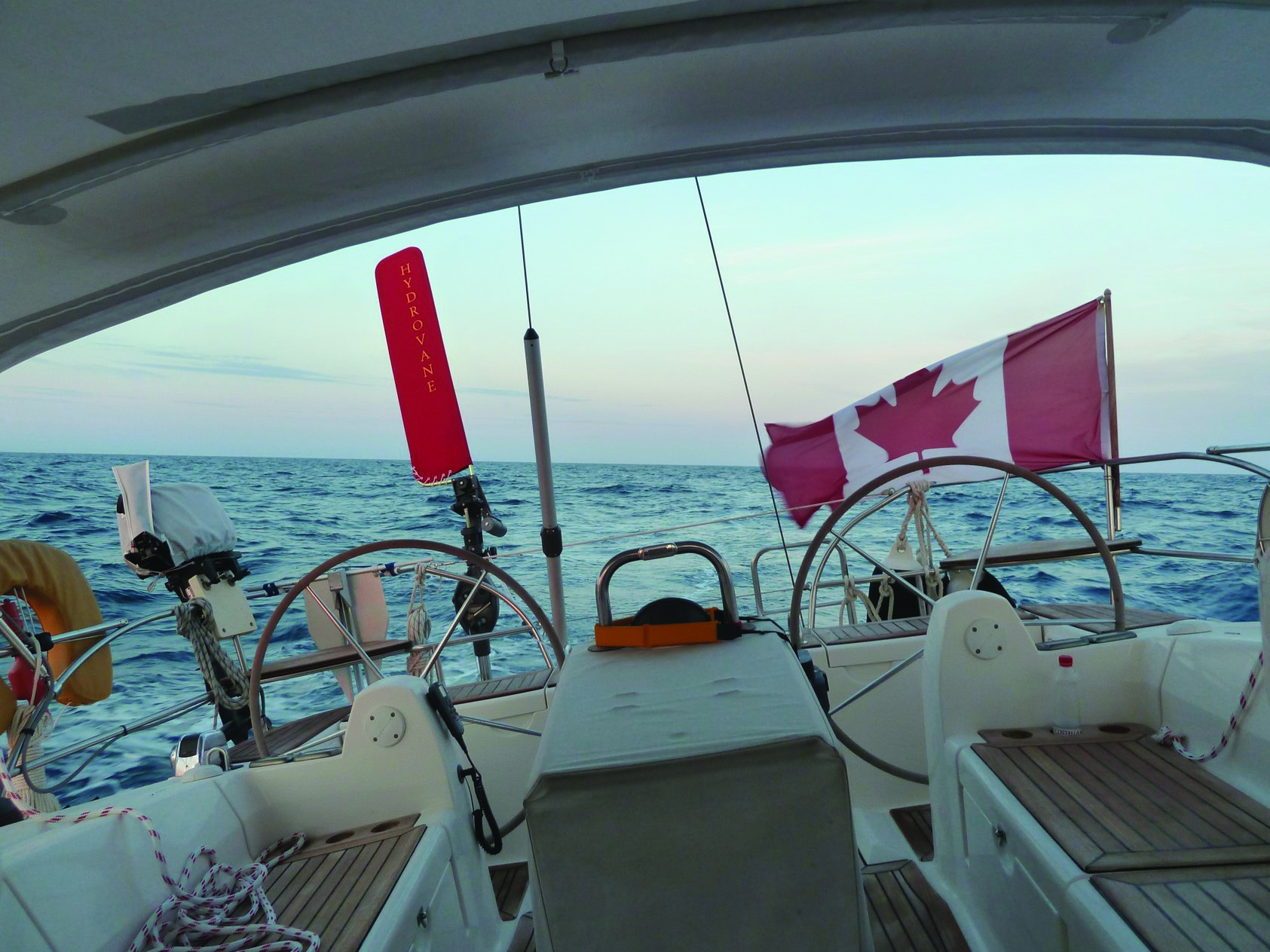
 Offshore/Rhodes/Reliant 40/41
Offshore/Rhodes/Reliant 40/41
Read Siggy’s 2009 email about surviving the Queen’s Birthday storm (6 yacht lost).
“Avoiding fatigue is important to “Survive your dream”. Fatigue is insidious in its effect on our faculties. We don’t even think of drinking and driving, yet people brag, “I was steering for18 hours, couldn’t leave the helm, because of the storm”. That’s stupid. That is a message that cruisers need to hear.”
From: Sigmund Baardsen
Sent: June 30, 2014
To: John Curry
Subject: Heading East
Dear John,
It was lovely to see Will and Sarah’s excellent (informative) piece in Latitude 38. They are inspirational. Please convey that to them.
MARY T is now on the hard. We have scraped off hundreds of 10-12mm barnacles and wet sanded the bottom. We do not consider that a paint failure, as La Paz Bay has 85F. water temp and is rich in nutrients. After three weeks, our anchor chain is the size of your arm, with marine growth. Unlike the Chesapeake, where marine life is dying of eutrefaction, due to industrial and agricultural pollution and mostlythe pig farms, here the oyster, clam and crab fisheries are prospering.
Carol is sewing covers for all the new varnish. The first 6 coats applied three months ago, at Catalina are already breaking down and have been re-coated, with another three. God I am hating varnish. It’s a mug’s game, south of 40 Deg.
Everything is removed from deck and/or double lashed, on account of hurricanes. The jack stands are well chained and the boats are jammed in so tightly that it is unlikely that any individual boat could go down. The yard is a far cry from the Cherubini Yachts yard. Here it is dirt aprons, flea-bitten dogs and dog shit everywhere, abandon boats, broken and abandon boat parts everywhere. It is a place of broken dreams, yet it is familiar, comfortable and we somehow find hope here. There is happily no travel lift, but instead a there is a cement launch-ramp, into the water and a big submersible trailer with hydraulic arms that support the boat.
We have found an inverse relationship, between appearance of the yard and care given the vessels. In the yards with flash new equipment, smart uniforms, travel lifts and fancy offices and restrooms, they care more about insurance, waivers, disclaimers, documentation and paperwork than they do about the boat. That is a sentiment not widely shared, particularly in the U.S..
Tomorrow we are off the boat, into a B&B operated by cruising friends, from 25 years back, at Moorings Pto. Escondido. That should be fun.
After a few days rest we are flying East, to sail on a sistership in the Chesapeake Bay/Long Island Sound area. The Annapolis boat show is on our itinerary.
Will you be there?
We have seen as least six new HYDROVANES here in this yard alone. Your improvements are subtle. Congratulations. You seem to be not only holding your own but gaining against the electric auto pilots. The HYDROVANE/tiller pilot combination must be much more economical as well as versatile than an equivalent under- deck autopilot.
Coming down the coast we had a few 168/mile days, with three reefs in the main and a scrap of jib. that’s not bad for an old boat with a 27 foot waterline.
On the 6th night, a threaded stem-ball, unscrewed from the control rod. (My fault, not yours). We had to had steer. It was exhausting. With fatigue we started to make slow decisions and bad decisions. Rather continue, deeper into folly, we hove-to (a forgotten virtue) and rested. At daylight we put into the salt works at Cedros Island, where there is a machine shop. I was able to make the repair, with parts on board in fifteen minutes. Then we slept for fifteen hours straight.
Avoiding fatigue is important to “Survive your dream”. Fatigue is insidious in its effect on our faculties. We don’t even think of drinking and driving, yet people brag, “I was steering for18 hours, couldn’t leave the helm, because of the storm”. That’s stupid. That is a message that cruisers need to hear.
Congratulations on helping so many to achieve and survive their dreams.
Sigmund
Contact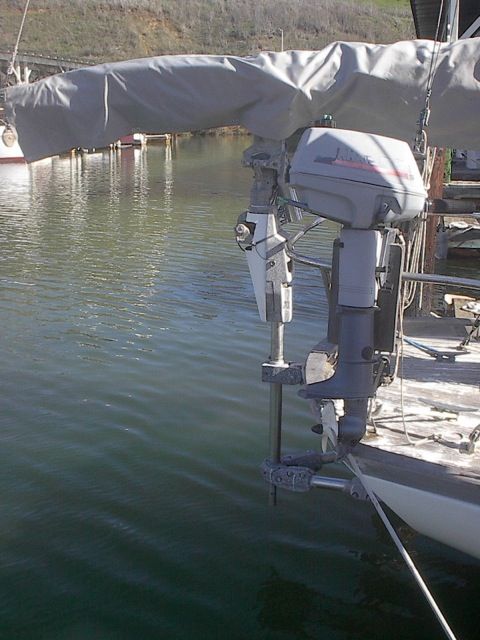
 Scandia 32
Scandia 32
“I just wanted to tell that I am very pleased with my vane, ‘Atilla’.”
“He worked exactly as promised, first time out.”
From: Arthur Robey
Sent: June 27, 2014
To: Hydrovane
Subject: Thank you.
Sorry about the delay. Life got in the way.
I just wanted to tell that I am very pleased with my vane, ‘Atilla’.
He worked exactly as promised, first time out.
I am thinking that I should invest in two more for my little yacht.
Regards,
Arthur Robey
 Hallberg Rassy 412
Hallberg Rassy 412
“[Helga’s] ability to sail the boat smoothly and quickly astonished me even after reading various reviews before we purchased. My wife is a bit prone to seasickness and we clearly notice the difference as soon as Helga is engaged or dis-engaged.”
From: Peter Bamford
To: John Curry
Subject: FW: Hallberg Rassy 412
Date: 22 Jun 2014
John, having used our Hydrovane (nicknamed ‘Helga”!) on and off for a couple of weeks I thought I would send you some reflections.
Overall when Helga is working she is amazing. Her ability to sail the boat smoothly and quickly astonished me even after reading various reviews before we purchased. My wife is a bit prone to seasickness and we clearly notice the difference as soon as Helga is engaged or dis-engaged. Shen even managed to steer the boat well when motorsailing on number of occasions. However, there are number of points worth mentioning or discussing:
- We had to fit Helga slightly off centre on the starboard side. We do have a bimini and a backstay where the main elements of the bridle and blocks are on the port side. The impact is that on starboard tack Helga works almost faultlessly on any point of sailing but really struggles to find clear air on port tack with the apparent wind forward of the beam. Obviously the heeling angle of the boat effectively lowers Helga further into the wind shadow. Given that we have few options with the bimini and backstay – please see photo – I’m not sure whether there any easy answers to this. I would welcome your thoughts.
- On our boat the normal genoa is low footed with minimal overlap but we do carry and use a ‘code zero’ sail in up to around 12/13 knots of wind with the true wind more than 55/60 degrees off the nose. The balance of boat is much more sensitive to changes in wind strength with this sail up and Helga needs a bit more adjustment as we go along.
- I also note your comments about removing the rudder for maneuvering in marinas. We have found this to be absolutely essential, particularly since our boat is fitted with a sail drive well forward rather than a traditional propeller. With Helga’s rudder locked centre it is absolutely impossible to get any side ways kick on the stern when driving on to pontoons. We had a couple of quite embarrassing moments until I realized what the issue was!
- Please could you send me a couple of spare pins? I’ve read your comments about rotating the pins to prevent fatigue failures. I’d like keep two spare.
Regards,
Peter
Editor’s note: John’s response to Peter’s questions:- DIRTY AIR – You might be surprised to hear that we have never had a report of dirty air affecting performance when beating … although such is certainly possible/understandable. Part of the reason is that cruisers so rarely have to beat upwind and that is such an easy point of sail steering wise. If you ever do get in that situation again you can try:
- Shift the sheeting to the traveler (if you have one)
- Slack the main sheet a bit
- Put a reef in the mainsail
- There is an expression: ‘Gentlemen never go to weather’.
- HEADSAILS – If you have a true genoa with a low foot I always recommend having them recut to put the clew higher making the length of the sides more like an isosceles triangle so you can see beneath it and when you slack its sheet the sail doesn’t simply open at the top. Genoas are one purpose sails – meant to go upwind – a direction that cruisers try hard to avoid. When off the wind, even with the headsail on the leeward side it is often wise to put a pole on the clew to tighten up the sail – keep it from collapsing and filling. That collapsing and filling corrupts the boat balance sending confusing signals to the HV.
- RUDDER REMOVAL – For arrival in a marina it is much preferable to remove the rudder … unless you have an extra pair of hands to use the HV rudder – two rudders are better than one.
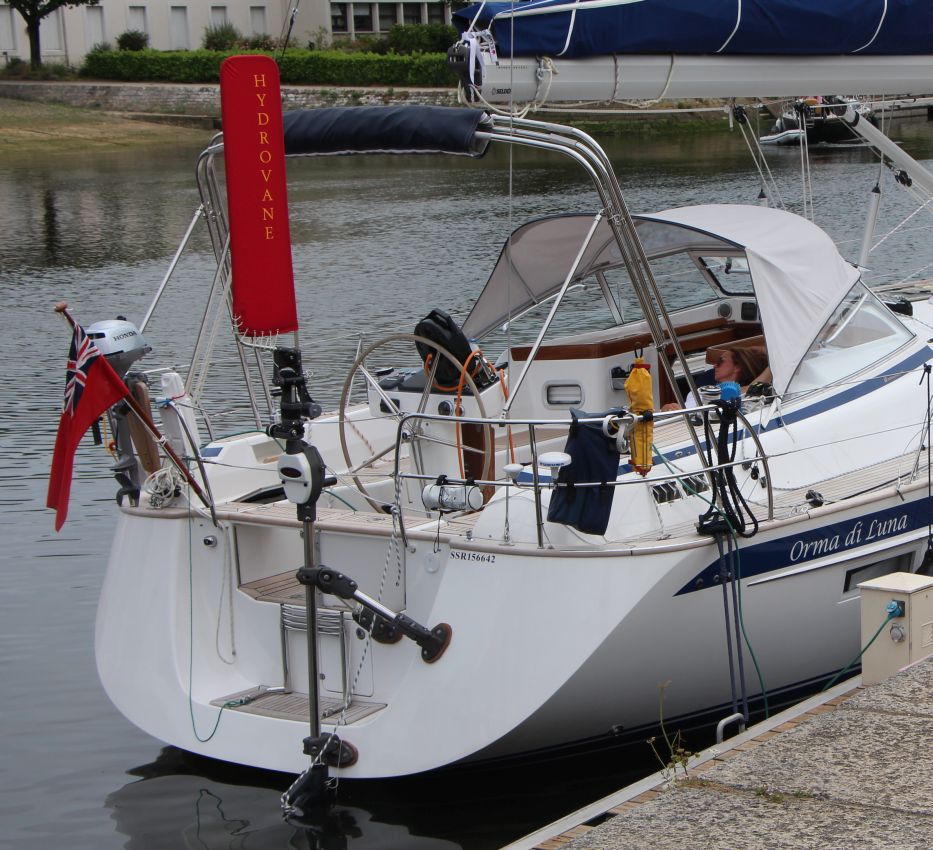
 Valiant 40
Valiant 40
“It functioned as advertised, much to the amazement of a couple of crew who weren’t aware of wind vanes.”
From: Mike Meador
Sent: June 21, 2014
To: Will Curry
Subject: RE: First time Hydrovane owner – Valiant 40
Will,
Thanks again for your support. Our maiden voyage from Florida to the Chesapeake Bay on our just-purchased 1991 Valiant 40 was uneventful. The Hydrovane hadn’t been used for at least six years; I [readied] it as you suggested, installed the rudder and vane, set up a control line, and quickly figured out how to engage it once we were underway. It functioned as advertised, much to the amazement of a couple of crew who weren’t aware of wind vanes. We used it for a third of the trip; other times we were forced to motor sail with the autopilot.
I understand the loose, no-lubrication engineering design, but what about using a bit of silicone grease on the worm gear?
Thanks,
Mike
Contact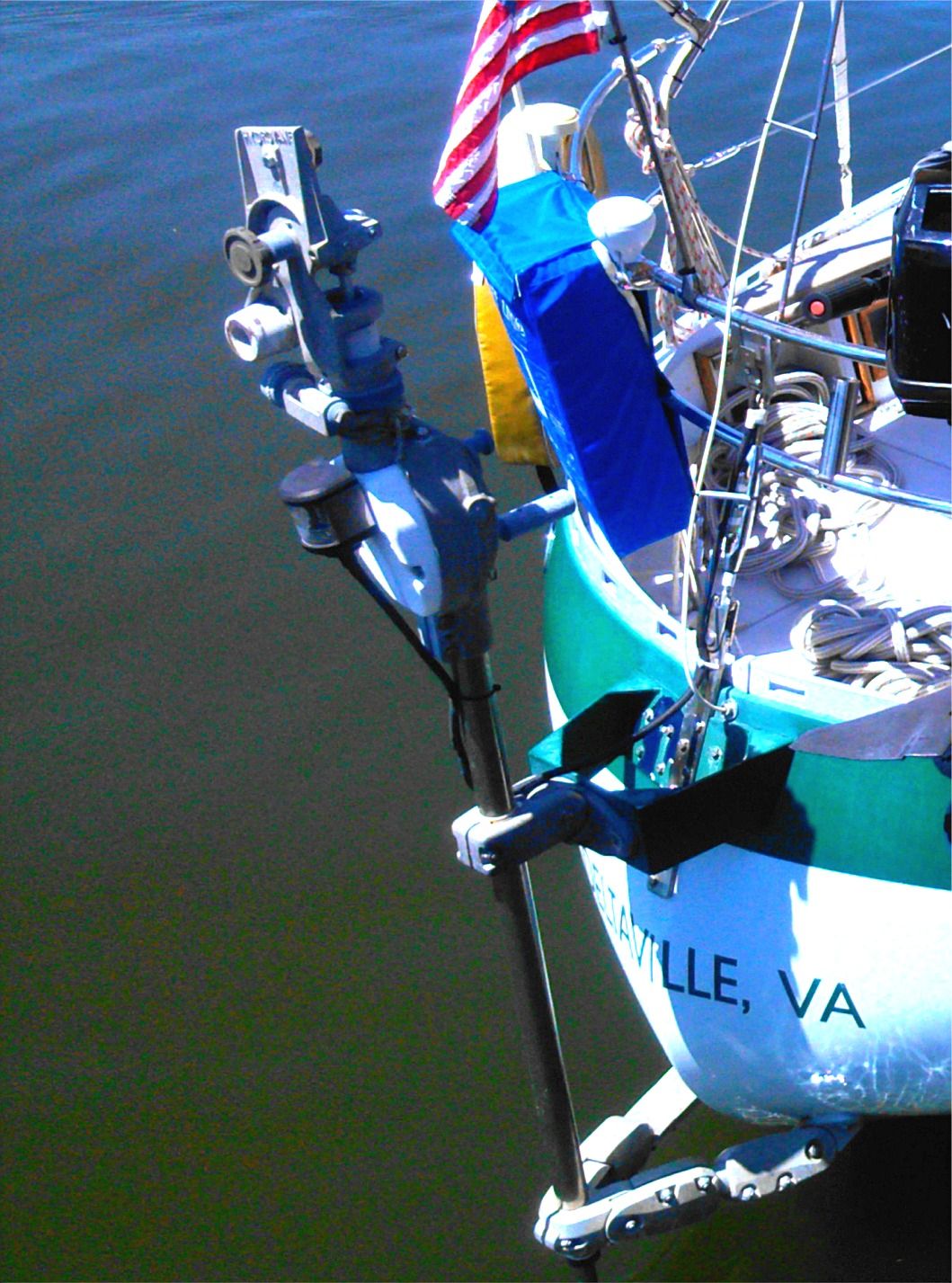
 Islander Freeport 36
Islander Freeport 36
“One of the bits of gear I’m most satisfied with is my Hydrovane. The Cadillac of vanes. It’s also the most expensive. But two things make it particularly good for me…”
From: Bob Scholl
Sent: September-18-13
To: Valerie Williams
Subject: Re: UPS SHIPPING
I installed and started to use when I left my home port on Sept 4. Unfortunately there was only 1 day of wind in the first 7. Since then the winds have varied from 5 to 35 knots (rounding Pt Conception on the California coast). The vane has worked well. I find I have to make some adjustments as the wind speed varies to keep the boat from rounding up. This adjustment is either on the vane or by a small adjustment on the boat helm.
Somehow we misconnected on the vane. The title of this email is stubby vane which is what I wanted for future installation of an arch. I was sent the standard vane. I am happy with this for the time being. If I do get the arch which may be someway down the road I may want to switch to the stubby.
I plan on posting a report on the Freeport Owners Yahoo Group to show the installation and indicate I am pleased with it. Note we did have to make some adjustments in the ribbing in the stern of the boat to make it work. The only installation problem so far has been the control arm at the top of the shaft came loose at the end of the first day.
Thanks,
Bob Scholl
…
Later Bob wrote to Latitude 38 magazine – quoted in the CHANGES section of the March 2014 issue:
“One of the bits of gear I’m most satisfied with is my Hydrovane. The Cadillac of vanes. It’s also the most expensive as it cost $6,000 installed. But two things make it particularly good for me. First, it could be installed offset, which it had to be because of the door that opens in the back of the boat cockpit. Because it’s offset, the rudder is out of the slipstream of the main rudder, and is therefore more efficient. Secondly, its a totally independent steering system, so if the main rudder fails, I can steer the boat using the vane rudder.”
Contact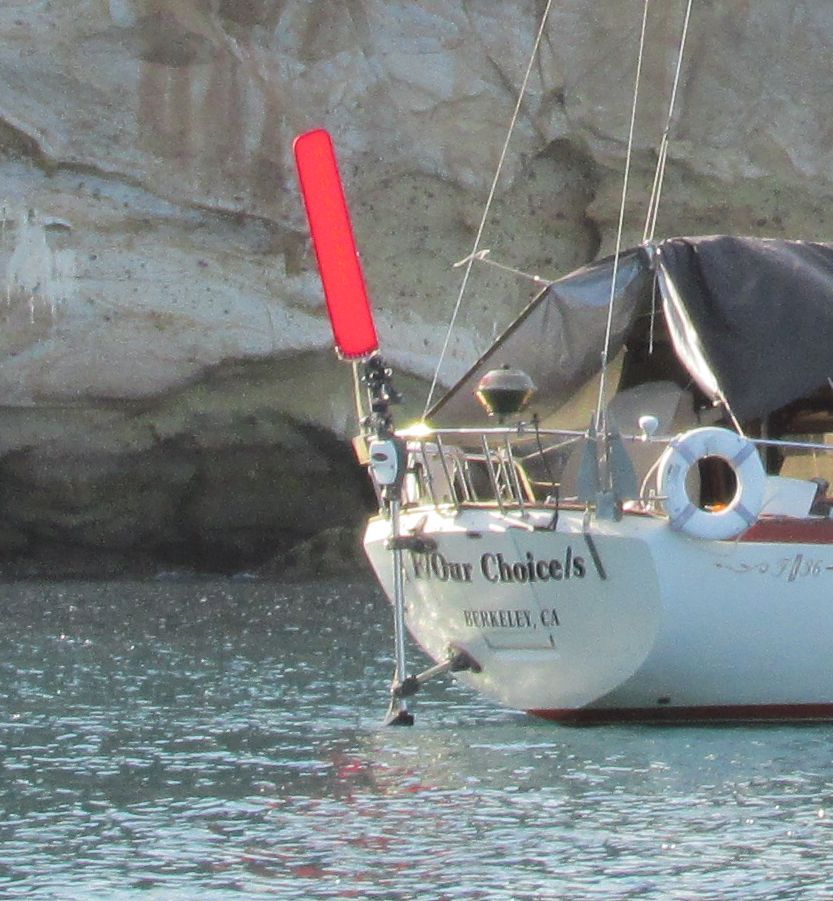
 Columbia 43
Columbia 43
Maid sail with Hydrovane from Honolulu to Kauai and back
“Great…”
From: Sergio Mitrotti
Sent: June 18, 2014
To: John Curry
Subject: Thanks from Honolulu
Hi John,
I finally tested the hydrovane I installed on my Columbia 43……
I sailed from Honolulu to Hanalei bay in Kauai, only 125 nautical miles…but with 25 knots wind gusting up. Going with the wind at 150 degrees, coming back sailing to weather 45 to 50 degrees.
I did not touch the steering wheel until was time to drop anchor…or ready to drop sail at the entrance of the marina..
great….
I may need a spare pin, just in case.
thank you
Sergio
Contact
 Cartwright 40
Cartwright 40
“A work of art really.”
From: DeLorme inReach
Sent: June-16-14
To: Valerie Williams
Subject: inReach message from Vince Denhertog
Thanks. This is my first time sailing with a Hydrovane and it performs so well under all kinds of conditions. A work of art really. Vince
Vince Denhertog sent this message from:
Lat 6.530857 Lon -156.668923
This message was sent to you using the DeLorme inReach two-way satellite communicator with GPS.
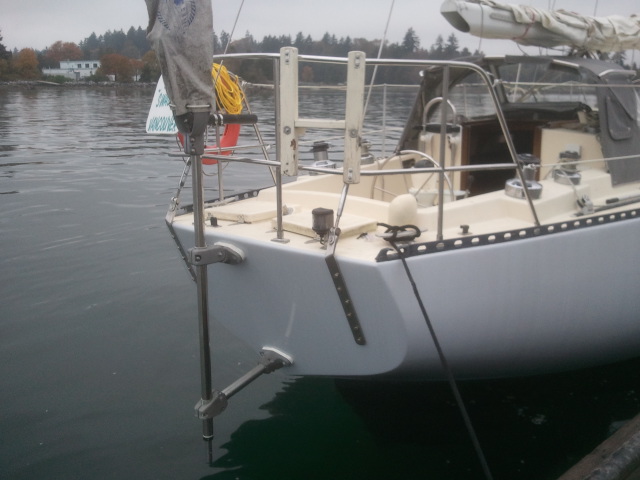
 Laurin 32 - Sooo disappointed
Laurin 32 - Sooo disappointed
“Honestly Will, I’m joking of course – the rudder is magnifique, it worked after 5 second trial.”
From: Ulf Olsson
Date: Jun 10, 2014
Subject: Re: Hydrovane on Clary
To: Will Curry
Hi Will,
so now the first report from Clary with Hydrovane – we are soooooo disappointed, the rudder does not work at all, the vane is f______g up and the rudder goes all ways – what is this for joke ……
Honestly Will, I´m joking of course – the rudder is magnifique, it worked after 5 second trial. we have sailed up to 30 knots and we have a new member onboard, even during reefing the rudder keep Clary in perfect position – I´m super impressed
The only issue I have is steering in the harbour – so far I´m locking the rudder and steer wirth my original rudder but Clary reacts prettys slow – maybe I have to play with both rudder the same time – here ther is something to learn – hints are welcome.
Regards
//Ulf
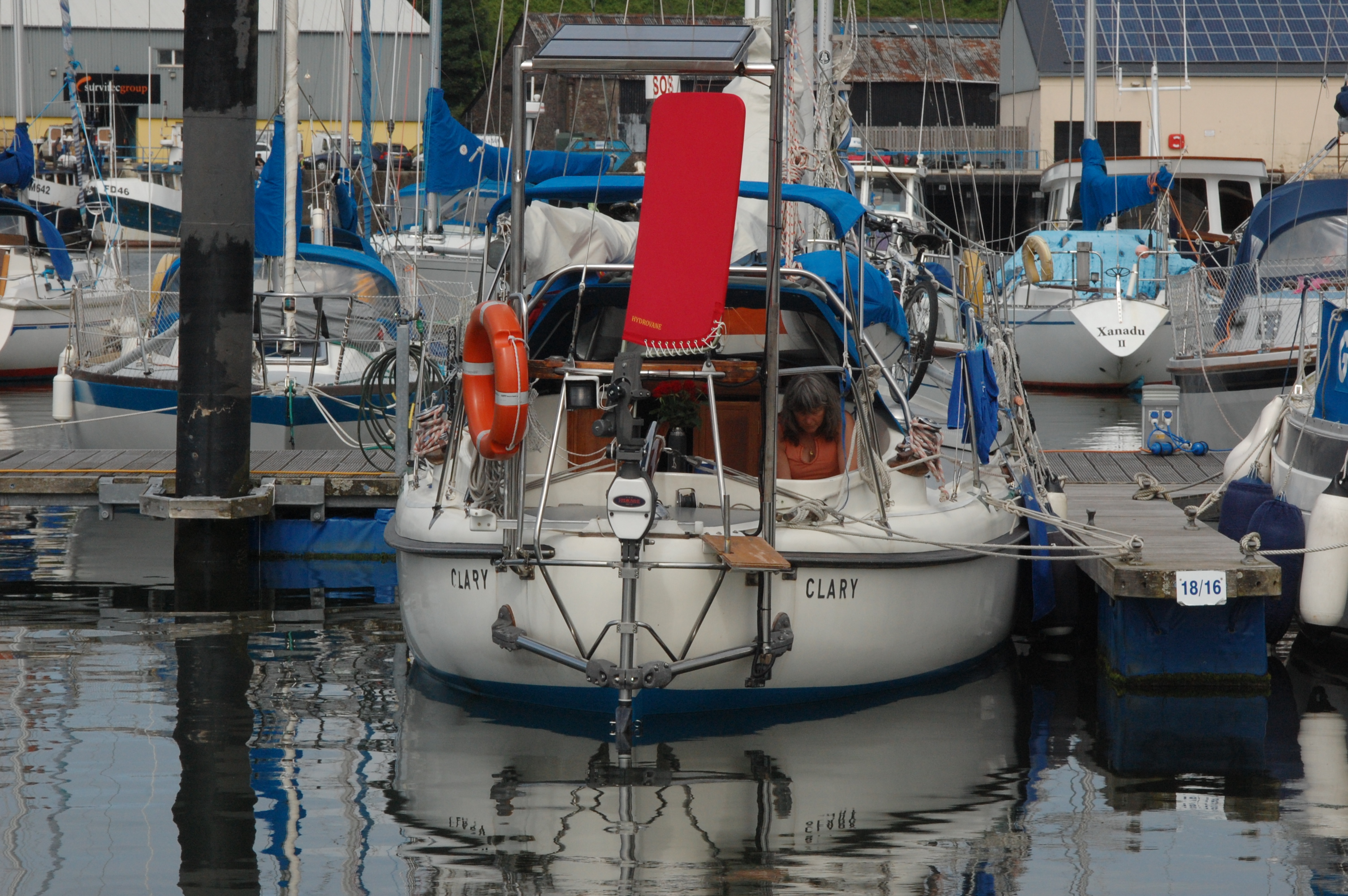
 Alan Pape 41 - Collision!
Alan Pape 41 - Collision!
“Having just replaced the outer tube and being very pleased with my old Hydrovane’s renewed performance I managed to get myself tangled up with a 100,000 tonne container ship.”
“My old HV was pretty good, but the new one is even better. I am sure that no other windvane on the market can match this very important characteristic for me
From: Bob Williams
Sent: April-21-14
To: Sarah Curry
Subject: Re: Hydrovane Parts
Hi Sarah,
It seems I am fated to purchase a new wind vane right about now. Having just replaced the outer tube and being very pleased with my old Hydrovane’s renewed performance I managed to get myself tangled up with a 100,000 tonne container ship. Of course Sylph came off second best, and the wind vane took the brunt of the collision, so it is now completely wrecked. I think the only thing salvageable from it will be the rudder and the brackets.
All very distressing but I am counting my blessings – Sylph is still afloat and my cat and I are alive and unhurt. Meanwhile, nearby to where I am, the South Korean ferry sank with tragic loss of life, which puts our own small disasters into a broader perspective.
So I am now back in Fukuoka, Japan licking my wounds. I received the mid-bearing, but ironically now have no wind vane to install it in. Bother!
Could you please advise how much a new unit will cost, minus the rudder and the mounting brackets, plus shipping costs to the previous address I gave you to Japan.
And an estimated time that you might be able to put one together and ship it.
Thank you for your help.
Best regards,
Bob Williams
SY Sylph VI
blog.mailasail.com/sylph
—
From: Bob Williams
Sent: June-02-14
To: Valerie Williams
Subject: Re: Hydrovane
Hi Valerie,
….My old HV was pretty good, but the new one is even better. I am sure that no other windvane on the market can match this very important characteristic for me, especially as I hate to motor.
Right now I am drifting around in the middle of the Sea of Japan waiting for some wind – not even the Hydrovane works when there is no wind.
Regards,
Bob Williams
SY Sylph VI
blog.mailasail.com/sylph
